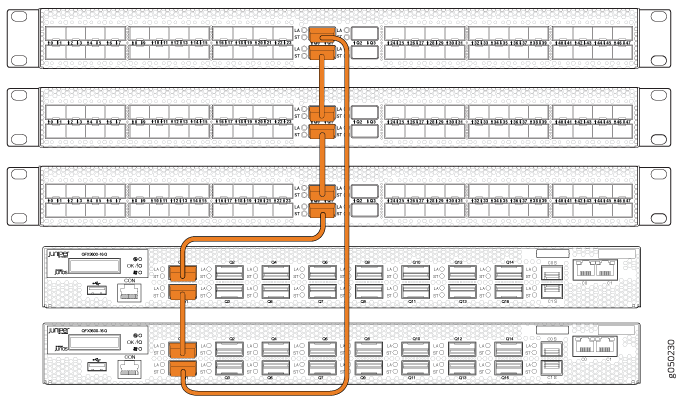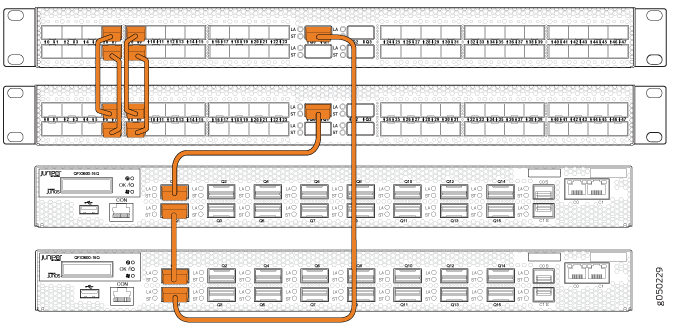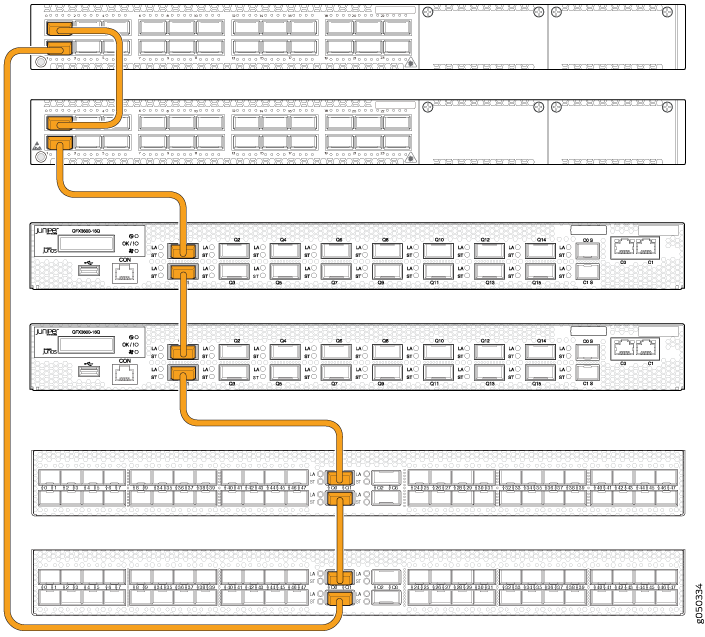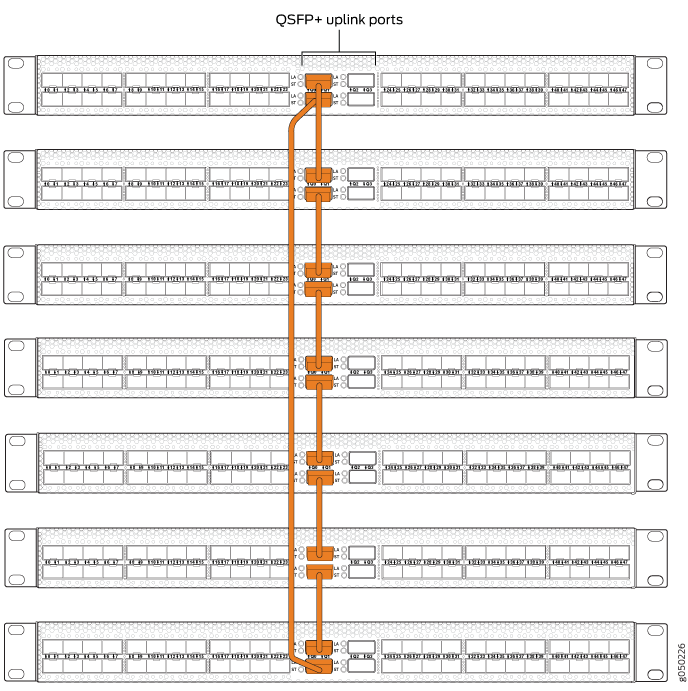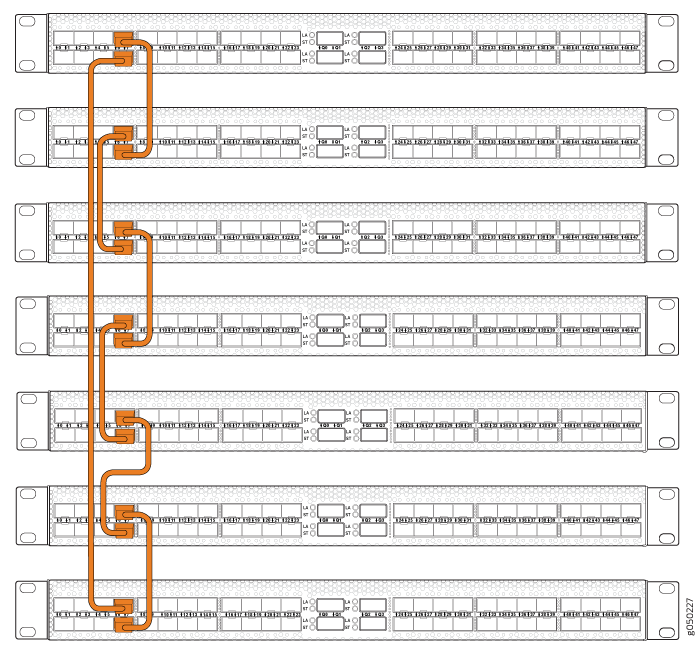Connecting QFX Series and EX Series Switches in a QFX Virtual Chassis
Connecting QFX Series and EX Series Switches in a QFX Virtual Chassis
In a QFX Virtual Chassis, you can connect up to 10 standalone QFX5100, QFX3600, QFX3500, and EX4300 switches except EX4300-48MP and EX4300-48MP-S switches into a QFX Series Virtual Chassis and manage the interconnected switches as a single chassis. Unlike a Virtual Chassis Fabric (VCF), which is cabled in a spine and leaf topology, the QFX Virtual Chassis is cabled in a ring topology. For Virtual Chassis Fabric cabling examples, see Connecting a QFX5100 Device in a Virtual Chassis Fabric.
As of Junos Release 17.3R1, you can also connect select models of the QFX5100 in the line card role in a QFX5110 Virtual Chassis. See Connecting QFX5110 and QFX5100 Members in a QFX5110 Virtual Chassis.
This topic describes how to cable QFX Series switches and EX4300 switches into a QFX Virtual Chassis.
- Before You Start
- Valid Configurations
- Cabling QFX3500 Switches in a QFX5100 Virtual Chassis
- Cabling QFX3600 Switches in a QFX Virtual Chassis
- Cabling a Mixed QFX Virtual Chassis
Before You Start
You configure a QFX Series Virtual Chassis by configuring the switch interfaces into Virtual Chassis ports (VCPs). VCPs connect switches together to form a Virtual Chassis, and are responsible for passing all data and control traffic between member switches in the Virtual Chassis. All non-channelized QSFP+ uplink interfaces on standalone QFX5100 switches can be configured into VCPs. All fixed SFP+ interfaces on QFX5100-96S switches can also be configured into VCPs.
Use the following interfaces to create VCPs:
-
On QFX5100, non-channelized QSFP+ uplink interfaces. All fixed SFP+ interfaces on the QFX5100-96S switches are also available.
-
On EX4300 switches, the built-in QSFP+ ports are dedicated VCPs by default. In 48-port EX4300 switches except EX4300-48MP and EX4300-48MP-S switches, you can use the QSFP+ ports as network ports or as VCPs. You can also use the SFP+ uplink module ports as VCPs by configuring these ports as VCPs.
In EX4300-48MP and EX4300-48MP-S switches, you can use only the built-in QSFP+ ports as VCPs. You cannot configure the ports on the uplink module in EX4300-48MP and EX4300-48MP-S switches to Virtual Chassis ports (VCPs).
-
On QFX3500 and QFX3600, all non-channelized QSFP+ and fixed SFP+ interfaces.
Use the 40-Gigabit QSFP+ interfaces for the VCPs.
The advantages of connecting multiple switches into a Virtual Chassis include better-managed bandwidth at a network layer, simplified configuration and maintenance because multiple devices can be managed as a single device, increased fault tolerance and high availability (HA) because a Virtual Chassis can remain active and network traffic can be redirected to other member switches when a single member switch fails, and a flatter, simplified Layer 2 network topology that minimizes or eliminates the need for loop prevention protocols such as Spanning Tree Protocol (STP).
You can increase VCP bandwidth between member switches by configuring multiple interfaces between the same two switches into VCPs. When multiple VCPs are interconnecting the same two member switches, a Link Aggregation Group (LAG) bundle is automatically formed when the VCPs are on interfaces supporting identical speeds. For instance, if you have two 40-Gigabit QSFP+ interfaces configured as VCPs between member switches, a LAG with two member links with 80 Gbps of total bandwidth is formed. 10-Gigabit SFP+ and 40-Gigabit QSFP+ interfaces configured as VCPs cannot be members of the same LAG, however. The Virtual Chassis feature is not applicable to QFX devices in a QFabric.
Virtual Chassis can be installed in a single rack, multiple racks, or in wire closets.
Valid Configurations
Valid configurations are:
-
All QFX5100 members–in a ring topology this is Virtual Chassis; in a spine and leaf topology this is a Virtual Chassis Fabric (VCF). For a cabling example of spine and leaf, see Connecting a QFX5100 Device in a Virtual Chassis Fabric.
-
All QFX3600 members
-
All QFX3500 members
-
A mixture of QFX3600 and QFX3500 members
-
A mixture of QFX5100, QFX3600, and QFX3500 members–use the QFX5100 switches as primary and backup whenever possible.
-
A mixture of QFX5100, QFX3600, QFX3500, and EX4300 members except EX4300-48MP and EX4300-48MP-S switches. EX4300 switches as the primary or backup is not supported; use QFX5100 switches in these roles whenever possible.
An all EX4300 member is simply considered an EX4300 Virtual Chassis (see Understanding EX Series Virtual Chassis).
If the QSFP+ interfaces are not available for VCP, 10-Gigbit interfaces can be used.
All members of the Virtual Chassis are required to run the same
Junos OS Release. You can check the version and release by issuing
the show chassis version CLI command.
Cabling QFX3500 Switches in a QFX5100 Virtual Chassis
Cabling QFX3600 Switches in a QFX Virtual Chassis
See Figure 3 for a diagram of configuring an exclusive QFX3600 Virtual Chassis.
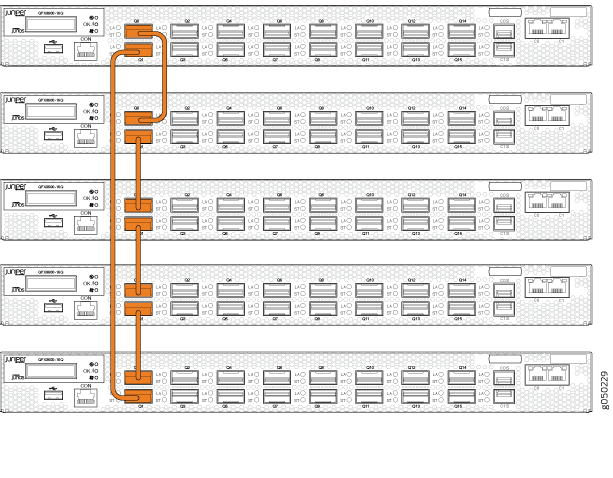
Cabling a Mixed QFX Virtual Chassis
A mixed QFX Virtual Chassis is a mixture of QFX5100 , QFX3500, QFX3600, or EX4300 switches except EX4300-48MP and EX4300-48MP-S switches in a ring topology. Always configure a QFX5100 as the primary and backup devices when they are available. See Figure 4 for an example using the 40-Gigabit QSFP+ ports and Figure 5 for an example using both 40-Gigabit and 10-Gigabit SFP+ ports. Figure 6 shows QFX5100-24Q switches as the primary and backup cabled in a ring to QFX3500 and QFX3600 switches.
